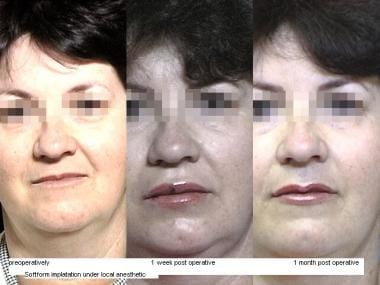Background
Cosmetic lip augmentation consists of the enlargement and reshaping of otherwise normal lips to improve their dimensional relation with the patient's nose, teeth, and surrounding facial structures. The appearance of the lips is determined by the spatial relation of the lip structures with the teeth in a 3-dimensional space and by their function during animation and speech.
According to a study by Popenko et al, which sought to establish the most attractive lip measurements in white women by using focus groups to evaluate facial images, the dimensions judged to have the greatest attractiveness included a lip surface area making up 9.6% of the lower third of the face and an upper/lower lip ratio of 1:2. [1]
For information on other lip procedures, see Medscape Reference articles Lip Reduction and Lip Reconstruction Procedures.
History of the Procedure
Lip augmentation has been described at least as far back as the early 20th century. Miller describes a procedure to evert the lip with multiple small incisions, giving it the appearance of increased size. [2]
Women of all ethnic and social backgrounds have applied cosmetics to their lips to define or alter their appearance since the Stone Age. Tribal ceremonies involving the introduction of various materials in the upper and lower lip to alter their shape, usually with the intent to enlarge them, have been practiced in African tribes for centuries.
Problem
Cosmetic lip augmentation is defined as the procedure designed to augment and improve the shape a lip that is not affected by trauma or congenital deformity. Typically, the upper lip is treated more frequently and to a greater degree than the lower lip.
Etiology
Cosmetic deformities of the lips include both congenital and acquired etiologies. Some patients never develop adequate fullness in the lips; others develop atrophy of the soft tissue of the lips as they age.
Presentation
Cosmetic indications refer to lip size and shape.
An accurate physical examination determines the specific area of deficiency or desired enhancement. Specifically, evaluate the patient's occlusion, maxillary-mandibular relations, and aging pattern. A general evaluation of the relation between the upper lip and the incisors reveals the appropriate course of action. Dr Bahaman Guyurion summarized the following algorithm approach to physical evaluation prior to lip augmentation:
-
Optimal incisor show - Conservative augmentation by fat transfer or dermis fat graft
-
Excessive incisor show - Augmentation by fat transfer or dermis fat graft
-
Inadequate incisor show, long lip - Lip shortening and lift with incision at nasal base ("buffalo horn") in young patients with acute columella-labial angle or incision at vermillion border in older patients with perioral rhytids
-
Inadequate incisor show, normal lip length - Maxillary lengthening with possible lip augmentation
Indications
Cosmetic indications include patients who desire a fuller or more shapely upper or lower lip and who are otherwise in good health.
Relevant Anatomy
Lip augmentation (see the image below) consists of the reshaping and/or enlargement of the visible portion of the lip, the vermillion. Alteration of the shape of the Cupid's bow and of the relation between the vermillion and the skin underlying the nasal columella also fall within the category of lip augmentation.
 SoftForm lip implantation. Gore-Tex (W.L. Gore & Associates) makes both solid implantable threads in different sizes and SoftForm, which is hollow down the length.
SoftForm lip implantation. Gore-Tex (W.L. Gore & Associates) makes both solid implantable threads in different sizes and SoftForm, which is hollow down the length.
The upper lip extends from the base of the nose superiorly to the nasolabial folds laterally and to the free edge of the vermilion border inferiorly. The lower lip extends from the superior free vermilion edge superiorly, to the commissures laterally, and to the mandible inferiorly. Around the circumferential vermilion-skin border, a fine line of pale skin accentuates the color difference between the vermilion and normal skin. For more information about the relevant anatomy, see Lips and Perioral Region Anatomy.
Also important is to consider the relationship between lip height and incisor show in the anatomic analysis. Evaluate possible maxillary hypoplasia and protrusion and consider the patient's occlusion status.
Contraindications
Contraindications for cosmetic lip augmentation include facial nerve disorders, recurrent herpes simplex lesions, diabetes, severe hypertension, history of multiple allergies, and/or autoimmune disorders.
-
SoftForm lip implantation. Gore-Tex (W.L. Gore & Associates) makes both solid implantable threads in different sizes and SoftForm, which is hollow down the length.






